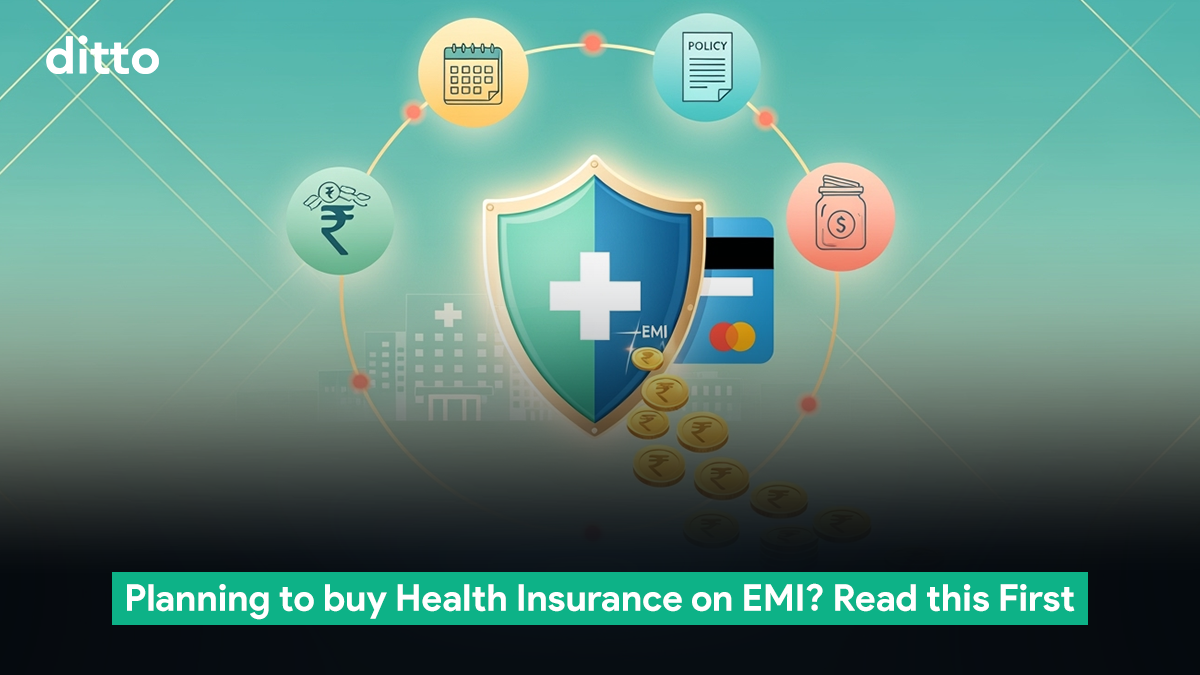| What is health insurance on EMI ? Health insurance on EMI is a facility that allows splitting the annual premium into equal instalments (monthly, quarterly, half-yearly). The EMI facility is either directly provided by the insurer or through another financier (like using a credit card). The IRDAI allows a grace period of 15 days for monthly EMIs on health insurance and 30 days for other payment modes. Although it sounds like a great deal, health insurance on EMI can make the policy costlier with added interest and complex in terms of claims. |
Most Indian households budget monthly, so buying health insurance on EMI feels convenient. You split a hefty, lump-sum premium into periodic payments, maintain a steady cash flow, and still enjoy uninterrupted health cover.
Salaried individuals in India reportedly spend 33% of their earnings on EMIs. So, adding one more EMI is only normal, right? But normal isn't always right. If you don’t know how health insurance on EMI works, you end up paying extra, risk policy lapse, and even struggle with delayed claims and deductions.
This guide will help you understand :
- What is health insurance on EMI
- How does health insurance on EMI work
- What are the advantages and disadvantages of buying health insurance on EMI, and
- The difference between buying health insurance on EMI and lump sum payment
(For simplicity, this guide uses the term “EMI” to cover all types of instalments; monthly, quarterly, and half-yearly).
Planning to buy insurance soon? No better time than now with 0% GST on life & health premiums. Check out our exclusive guide to know how the GST slash affects new policies and renewals.
Book a free call with Ditto and get personalised, zero-spam guidance from our IRDAI-certified advisors.
What is Health Insurance on EMI?
Health insurance on EMI is a unique facility that takes away the stress of paying a lump sum policy premium. IRDAI introduced this option in 2019 to boost affordability and penetration, and fast-tracked its rollout via an April 2020 circular after COVID pandemic.
In India, there are two distinct ways how health insurance on EMI works.
Insurer-offered EMI
This is where you’re allowed to buy health insurance on EMI by setting up an e-mandate on your account (via UPI, Netbanking, credit/debit cards). Then your annual premium gets split into monthly, quarterly, or half-yearly instalments. The cover stays active while you pay the dues. In case the debit fails, you have a grace window of 15-30 days to make the payment, depending on your mode of payment.
However, very few insurers in India offer this facility. A good example is Star Health Insurance, which offers EMI facility on its flagship plans like Super Star, and Star Comprehensive.
Pro tips to manage insurer-offered health insurance on EMI:
- Keep the debit date right after your salary hits the account.
- Set a low-balance alert.
- Update the mandate details if you change your bank account.
Here’s a monthly premium breakdown for the insurer-EMI option of Star Health’s Super Star plan.The calculation estimate is for a 25-year-old individual opting for a sum assured of ₹15L.
| Profile | Annual pay | Half-yearly pay | Quarterly pay | Monthly pay |
|---|---|---|---|---|
| 25-yr old Individual | ₹13,282 | ₹6,773 (2% higher) | ₹3,418 (2.9% higher) | ₹1,141 (3.08% higher) |
Clearly, one pays a lot less as an annual premium compared to half-yearly, quarterly, or monthly pay.
Red Flags of Insurer-Offered Health Insurance on EMI:
- Higher lapse risk: If you miss an instalment and fail to pay within the grace period, the policy can lapse.
- Raising a claim with EMIs pending: If you file a claim while EMIs are due, the remaining premium for that policy year becomes payable immediately.
- Set-off from claim: Insurers can recover any unpaid instalments from your claim amount before paying you (usually mentioned in the policy wording).
Example: Say the annual premium of ₹30,000 was split into ₹2,600 monthly. After 6 payments (i.e., after paying ₹15,600), you raise a claim. Then, the unpaid ₹14,400 becomes due and is deducted from your payout. Even if only one EMI was paid, the rest becomes immediately payable.
NBFC Loan or Credit-card EMI
This is by far the most common way to buy health insurance on EMI, where you swipe your credit card to pay the full annual premium upfront. While your bank settles the full premium for the insurer, you agree to repay the provider in subsequent EMIs (with additional charges and interest).
This is where it gets tricky.
With credit-card EMIs, your policy stays active because the insurer gets the full premium upfront. However, missing an EMI can hurt your credit score. Card EMIs usually carry 14–18% interest, and if you miss a payment or pay only the minimum due, the charges can go up to 30% annually.
Pro tips to manage health insurance on EMI using credit card :
- Ensure your credit limit is sufficiently high, as paying the full premium may block usage until EMI conversion.
- Set autopay in full for the credit card bill.
- Align your EMI pay date with your salary cycle.
- Keep your credit card utilization under 30% to protect your credit score until you pay all EMIs.
| 💡 Did You Know? Most credit cards exclude insurance premiums from their rewards. So whether you pay your life/health/motor premium by card, it earns no points, miles, or cashback. The only real upside is the 45–55 day interest-free window which helps to maintain the cash flow. |
Don't fall for the “no-cost EMI” trap. Instead “know the cost’ right before you buy a health insurance plan in 2025. Book a call with Ditto to talk to our IRDAI-certified advisors right away!
How Does Health Insurance On EMI Work?
Here’s a clear breakdown of how health insurance on EMI works for insurer instalments and credit-card EMIs across different scenarios.
One Time Set Up
- With insurer offered EMIs : With insurer EMIs, once you set up auto-debit (UPI Autopay or eNACH), your annual premium is split into monthly, quarterly, or half-yearly instalments while coverage stays the same.
For example, a ₹30,000 annual premium is divided into 12 instalments. Instead of exactly ₹2,500/- a month, it comes to about ₹2,600 to ₹2,625/-.
Note: The difference is because of frequency loading—a small, built-in cost for paying in parts that covers admin and collection risk. There is no separate interest or hidden fee.
- With credit-card EMIs :The lender bank pays the full premium upfront to the insurer while blocking your credit card limit to repay in EMIs (including interest, GST, and processing charges)Using the same example from above, where the annual premium is ₹30,000 at 15% p.a. + 1% processing fee + GST 18% on charges, the EMI comes to ₹2,708/month, which means you end up paying ₹33,296/- for the entire year!
Month-to-month, quarterly, or half-yearly payment
- With insurer offered EMIs : IRDAI allows a grace period of 15 days (monthly) or 30 days (for others) if the NACH fails, and the coverage continues. However, beyond the grace period, unpaid payments can lead to policy lapse and affect continuity benefits (i.e., you lose all served waiting and moratorium periods).
For example, if the due date is on the 5th and the monthly debit fails, one should preferably pay by the 17th (i.e., within 15 days). If you pay, let's say, on the 25th (i.e., after 15 days), the policy may lapse because health insurance has no revival option after the grace period is over.
- With Credit Card EMIs: You know your premium is already paid in full, so there’s no risk of policy lapse on an immediate basis. But if you miss payment to the provider it will still charge a penalty and additional interest. This, in turn, hampers your credit score.
Let’s say your monthly health insurance on credit card EMI of ₹2,700/- is missed. The bank will charge the late fee and add interest as per the terms and conditions of the credit card, and will report delinquency unless you regularise payment. In the worst-case scenario, they may direct the insurer to cancel the policy and ask for a pro-rated refund.
Mid-Year Claims
- With insurer offered EMIs: If you have multiple instalments pending for your health insurance on EMI for a single year, the same will be deducted from your claim.
Let’s say, for an annual premium of ₹30,000 (@₹2,500/month), six installments are pending. So, from a claim of ₹1,50,000, ₹15,000 will be deducted (₹2500*6). Thus, your final payout would be ₹1,35,000. You will have to bear the rest out of your own pocket.
- With credit card EMIs:For credit card health insurance on EMI, claim payouts aren’t generally reduced but you still owe the missed payments to the bank. The more you delay, the more interest gets added as per the terms and conditions.
Pro Tip: Always opt for an insurer-offered health insurance plan on EMI for a smoother cash flow at the lowest cost. Use credit card-backed EMIs only if the insurer-offered EMI is not available and discounts cover the interest, additional fees, and GST.
New to buying health insurance in 2025? Here’s everything you need to know about how individual health insurance works in India.
What Are The Advantages And Disadvantages of Buying Health Insurance on EMI?
Most people buy health insurance on EMI for either of the two reasons:
- They lack the funds for a lump sum annual premium, or
- They don't want to block their money, fearing the need for liquid cash during emergencies.
So, it makes sense to compare the benefits and drawbacks of buying health insurance on EMI, and know who should go for it and who shouldn't.
| The Good | The Bad |
|---|---|
|
|
So, buying health insurance on EMI is a good option if you are :
- A first-time buyer considering ₹10L vs ₹25L floater health insurance, where EMIs can provide adequate coverage.
- A salaried professional with regular cash flow mitigating the chance of EMI skip.
- Buying a comprehensive, no-limit plan for your parents, which is generally expensive but becomes affordable with EMIs.
On the flip side, avoid buying health insurance on EMI if you are:
- Someone who can systematically save money in SIP, recurring deposits, or in liquid mutual funds to pay annual premiums.
- A credit card holder with high EMIs with high interest rates and foreclosure charges.
- A self-employed professional (like a freelancer) with irregular income.
Difference Between Buying Health Insurance on EMI and Lump Sum Payment
Here's a clear comparison table listing the key factors for buying health insurance on EMI vs lump-sum payment.
| Aspect | Health insurance on EMI | Lump Sum Payment |
|---|---|---|
| Cash flow | Smooth monthly outgo | One-time hit |
| Annual cost | Higher with credit card EMIs due to additional interest, GST, and other charges | Clean and lowest |
| Claim time | Any unpaid instalments are deducted from claim payout | No chance of pending instalments |
| Missed payments | Attracts late fees and impacts credit score | No scope of late fees or credit score impact |
| Complexity | Can be moderate to heavily complex with setting e-mandates and consenting to lender terms and conditions | A pure set-and-forget option |
| Smarter (and cheaper) alternatives to buying health insurance on EMI: a)Say yes to sinking-fund premium: Consider monthly auto-saving to a Recurring Deposit account and pay the insurer annually on maturity. b) Use credit card float instead of credit card EMI: Pay the annual premium of the health insurance using your credit card and ensure clearing the bill within the interest-free period. This will give you up to 45 interest-free days, minus EMI add-ons. |
Why Choose Ditto for Your Health Insurance?
At Ditto, our singular aim is to guide people into becoming confident insurance buyers. Whether you buy health insurance on EMI or pay the annual premium upfront, our IRDA-certified advisors can put you on the right track with unbiased and profitable recommendations.
To date, we’ve helped 7,00,000+ customers match their unique needs to the right health insurance policy. No wonder customers trust Ditto and recommend us to others.

The Bottom Line
Health insurance on EMI helps manage cash flow while keeping your cover intact. But if you can afford it, choose annual pay for simplicity and lower total cost. If you must use EMIs, prefer the insurer’s instalment option over credit-card EMIs, read the policy wording for claim-time set-offs or deductions, and repay within the grace period.
To pick the right health insurance plan, book a free call with Ditto and get personalised, zero-spam guidance from our IRDAI-certified advisors.
Frequently Asked Questions (FAQs)
Can I cancel my health insurance policy on EMI?
You can cancel your health insurance on EMI within the free-look period and get a refund minus the pro-rata risk premium, stamp duty, and any medical test charges. Some insurers allow cancellation of health insurance even after the free-look period (only if no claim was made) but they refund only the unused risk premium (pro-rata).
What should I check before choosing EMI?
Some basic checks that you need to know before choosing a health insurance on EMI are who you’re paying, how much is the interest and other charges, GST (if applicable), how long is the grace period, claim-time deduction for unpaid instalments, and renewal and portability terms and conditions.
Is “no-cost EMI” really free?
“No-cost EMI” isn’t really free; it’s just a marketing gimmick. You are still charged interest, but the cost remains hidden in merchant mark-ups, lost lump-sum discounts, or GST on the interest. If you run the math over 12 months, you will see how often you end up paying more than what you’d paid as a full premium upfront. The only upside is smoother cash flow management, not actual savings.
If I claim mid-year while instalments are pending, will I be paid?
Generally, yes, but the pending instalments will be deducted (or adjusted) from the final payout. Please refer to the policy wording for more information.
Does coverage always continue during grace?
IRDAI prescribes continuity of coverage and benefits during grace periods, provided the due premiums are paid within this period. Insurers mostly follow legacy phrasing relying on the 2024 Master Circular for the current rule set.
Last updated on:








